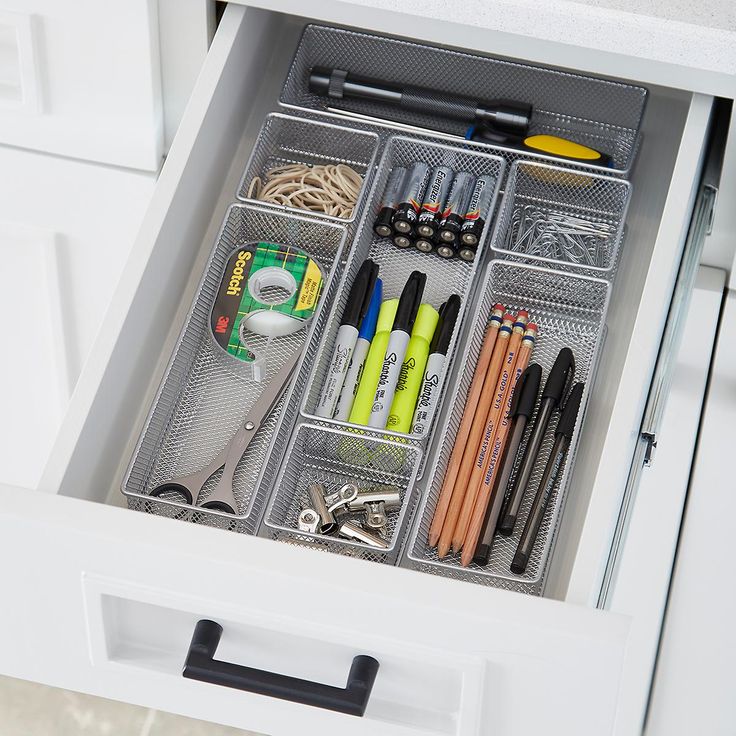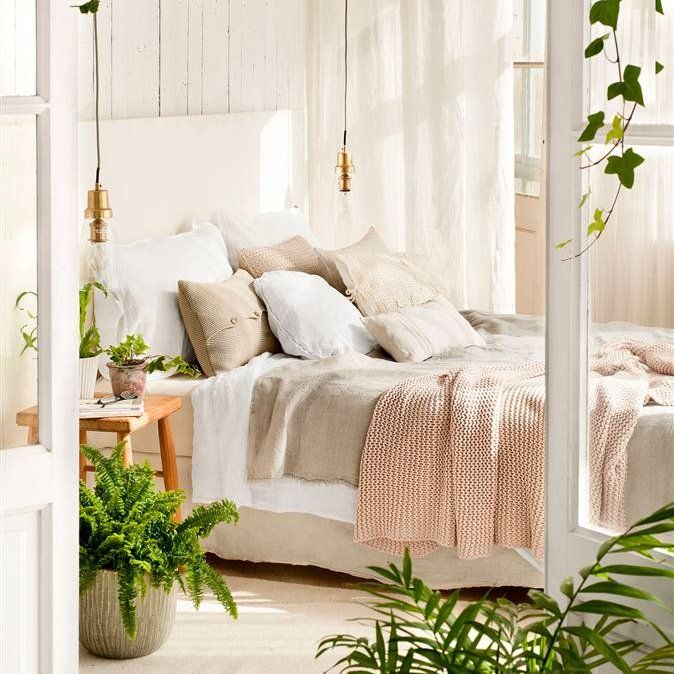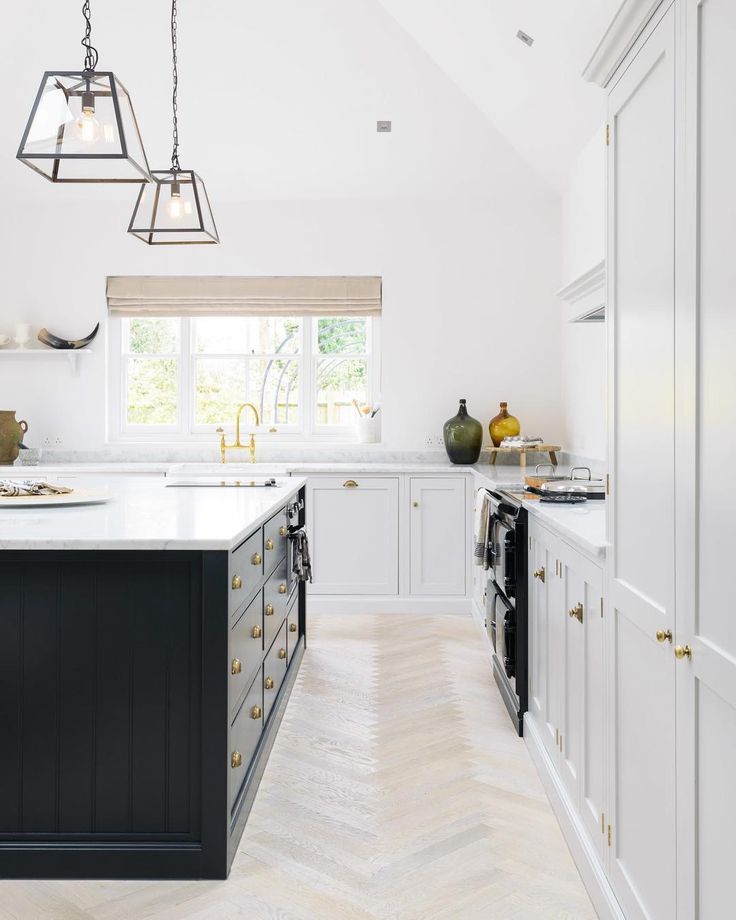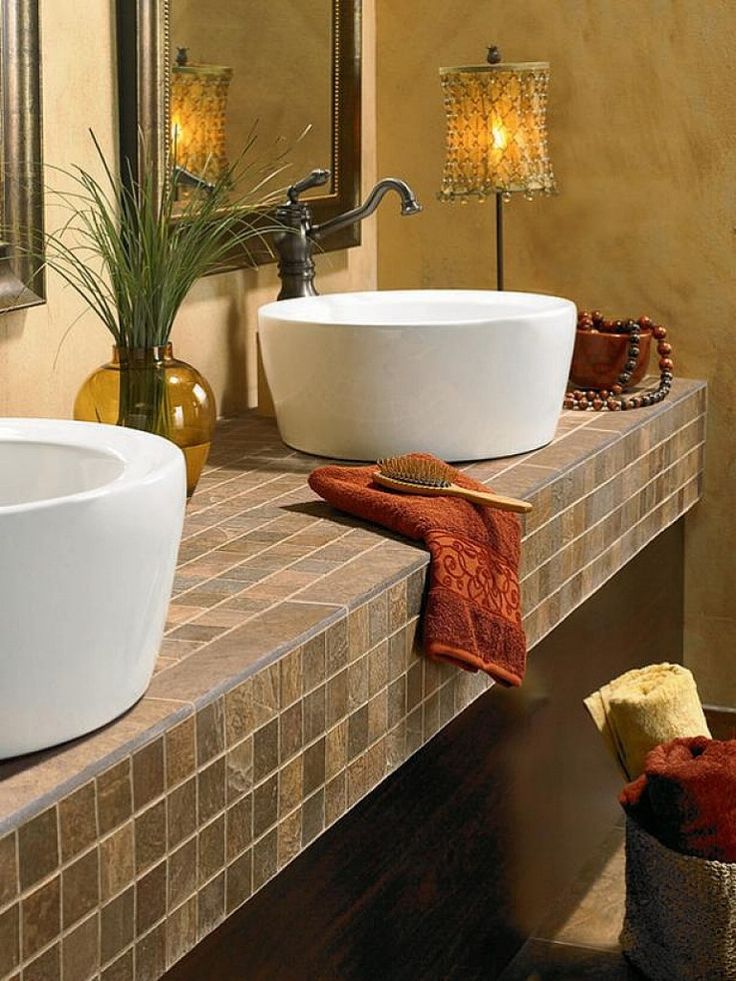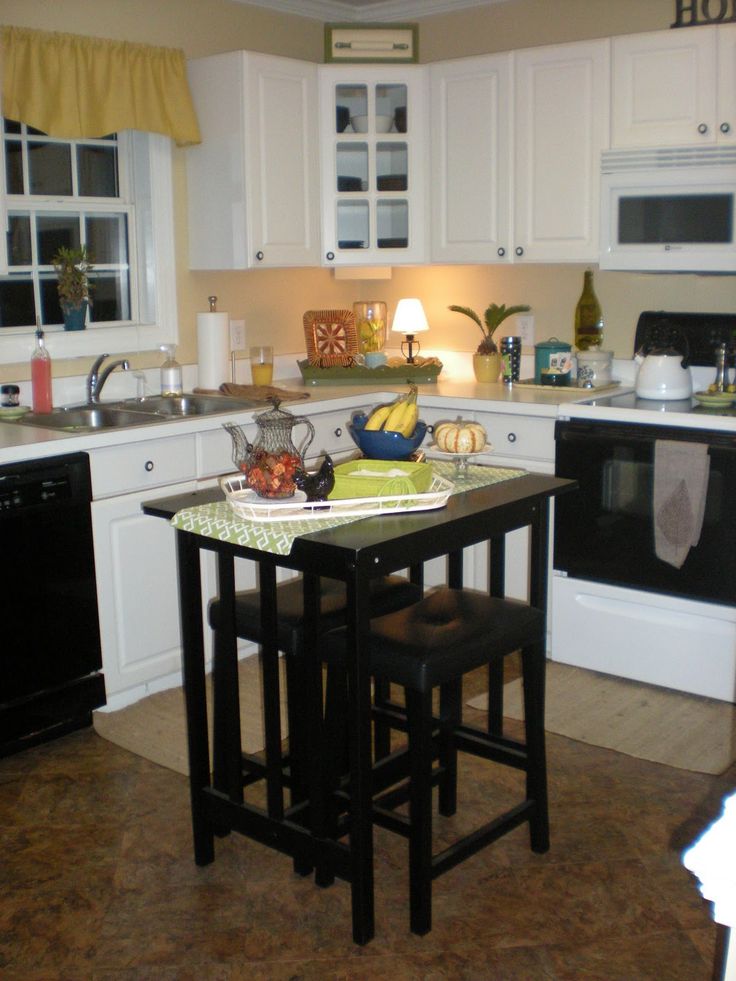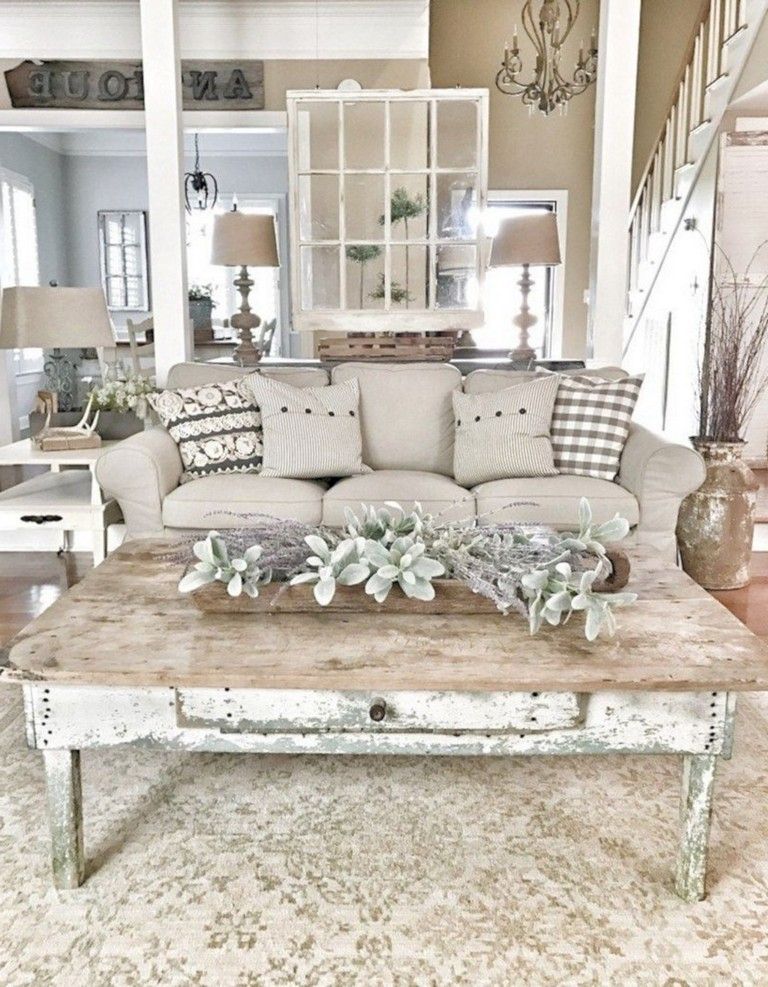Best wood for bathroom
A Complete Guide to the Best Wood for Bathroom Cabinets
One of the most important things to consider when planning your bathroom remodel is the best wood for bathroom cabinets. Of course, you should consider size, the number of cabinets, cabinets organization, and many other factors as well, but the material choice is critical to the project.
Above all else, wood is the material of choice for cabinetry. But even narrowing it down that far is not enough, because there are so many different varieties of wood to choose from.
What is the best wood for bathroom cabinets?
Let’s look at some of the best options...
Solid Wood
From an aesthetic standpoint, nothing beats solid wood for cabinets. Oak, maple, and birch are prime examples of beautiful hardwoods that you can use for bathroom cabinets. You can stain these solid woods to match the look you are seeking for your bathroom, and the variety of wood grains allow you to add a lot of customization.
Solid woods also hold up pretty well to bathroom conditions, though it’s crucial that the room is well-ventilated to prevent shower-produced humidity from warping the wood. Still, if your cabinets are solid wood and they happen to take damage, the repairs are simple compared to some other options.
Solid wood is particularly worth considering for a vanity bathroom design.
Oak
Oak is a classic hardwood used in many high-quality furniture pieces and cabinets. Oak is one of the hardest woods you can use for your cabinets, which makes it great for resistant damage and humidity. Oak is a very sturdy wood and is less prone to warp and rot in a bathroom environment.
Oak stains well but it can be uneven at times, with the grain darkening more in some spots than others. This results in a streaky appearance that may look a bit out of place in your remodel.
Birch
Birch is a pale-colored wood that you can polish to produce a beautiful sheen. The neutral color of birch makes it a strong choice if you want your cabinets to just blend in rather than being the star of the show.
If you are concerned about warping, birch is one of the best choices due to its warp-resistant properties. This is one wood that can definitely stand up to the bathroom humidity. As a bonus, birch is such an abundant tree that it has become one of the most affordable hardwoods out there.
Birch does, however, have its downsides. The wood tends to scratch easier than many other hardwoods. It is also difficult to stain without ending up with a blotchy appearance. This is because birch wood tends to be uneven in how porous it is.
Still, if you are on a budget, you are likely to find birch to be the best wood for bathroom vanity.
Maple
The slight reddish tint in the color of maple wood makes it a classic beauty. Maples are often used in cabinetry and furniture due to their even grain that gives a uniform appearance and allows for the wood to be sanded to a very smooth finish.
Maple is one of the hardest woods you will find, so it has high durability and is resistant to warping and cracking.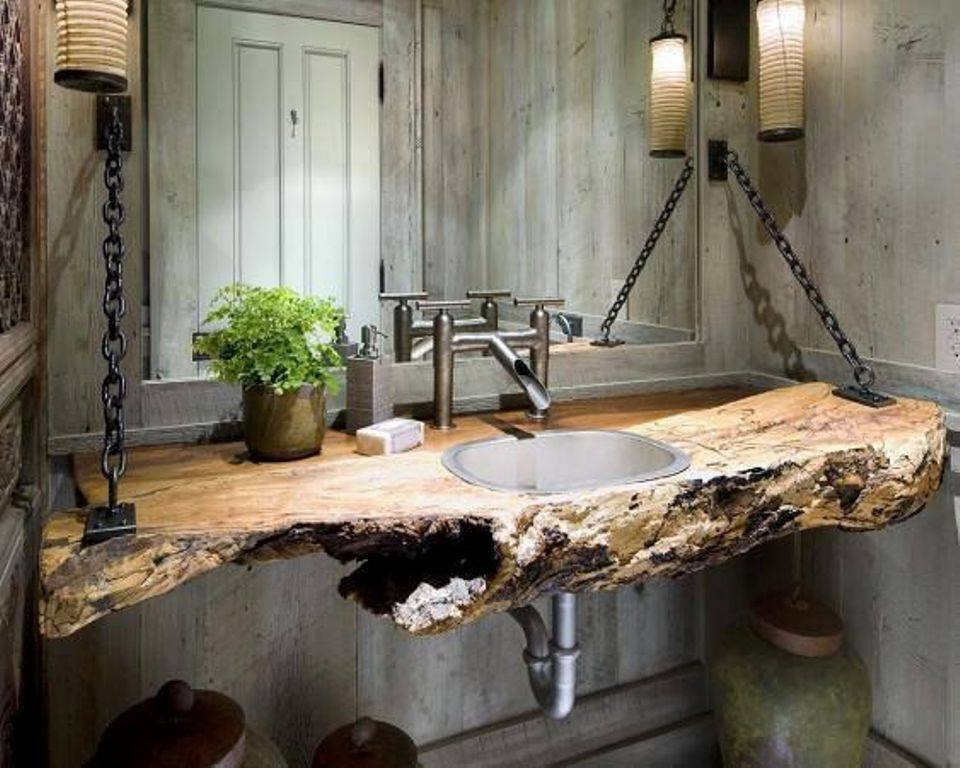 It isn’t the most affordable option, but maple comes in as a mid-priced wood choice.
It isn’t the most affordable option, but maple comes in as a mid-priced wood choice.
The downside to maple is that it isn’t the easiest wood to stay, and dark stains do not come out very well.
Plywood
An alternative to using solid wood for your bathroom cabinets is plywood. This option can be a little bit tricky because plywood comes in such a wide variety of sizes, qualities, and densities. If you go the plywood route, you’ll want to select a type of plywood that is as solid as possible. This means high-density plywood should be your preferred option.
While plywood doesn’t have the natural beauty of solid wood, it does offer some benefits. For one, it does not expand as much as solid wood does in humidity. This means it is less likely to warp and cause issues with over-expanding. Plywood also tends to hold up better to water damage, which is of course crucial in a bathroom setting.
Plywood is a cheap option, so if your budget is on the lower end this may be the best option.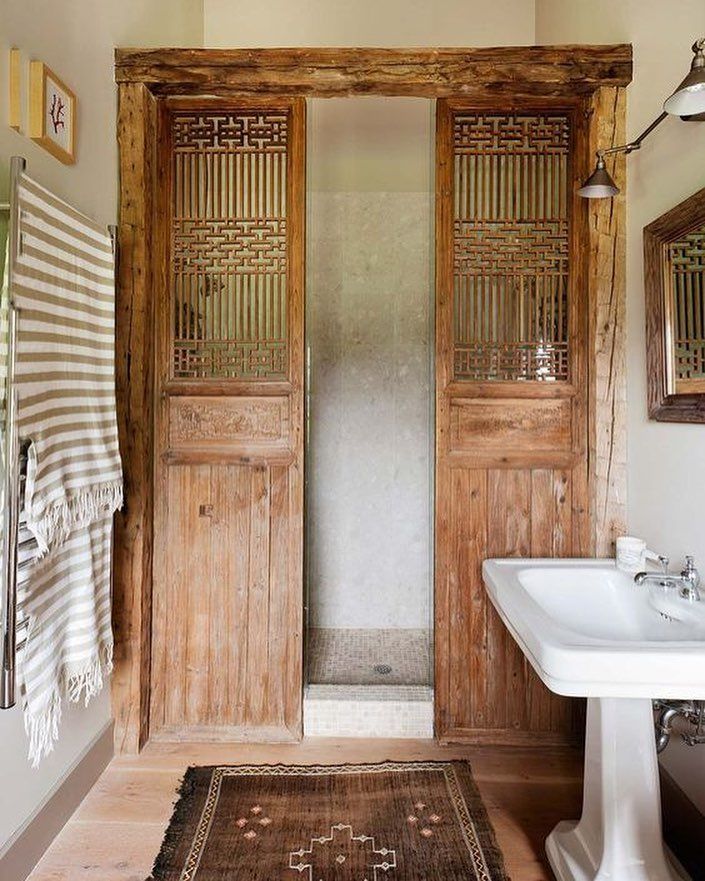
Medium Density Fiberboard (MDF)
Another option for your bathroom cabinets is MDF, which is a material comprised of various types of compressed wood. This is a material that when properly treated can be resistant to moisture from humidity, but you do want to make sure it doesn’t see too much direct contact with water as this can cause it to warp.
While it naturally does not have a particularly beautiful appearance, it does take paint very well which means you can paint it precisely the correct color to match your bathroom. It is also a very cost-effective option, and typically will be even more affordable than going the plywood route. Also, when damaged MDF is very difficult to repair. If you have to fix damaged MDF, it will be noticeable.
Wood for Bathroom Cabinets Shelving
Another consideration is the design and type of wood to use for the shelving in your bathroom cabinets.
All of the same options apply; solid wood, plywood, and MDF. Keep in mind, though, that you don’t have to use the same wood type for the inside storage as you do for the exterior.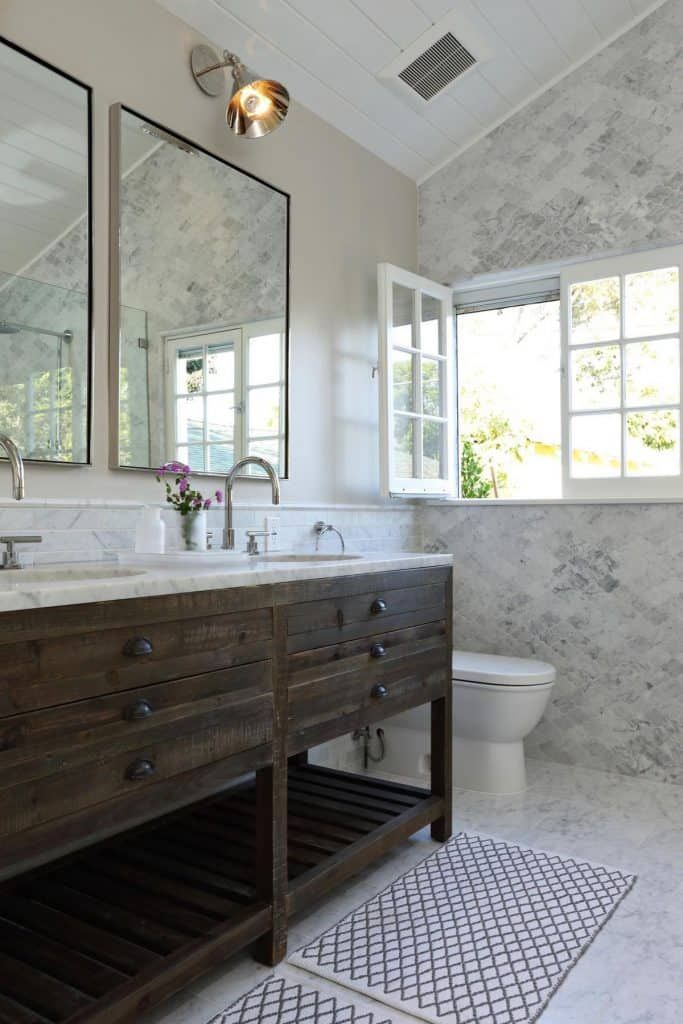 In fact, on the inside, it is often more cost-effective to use MDF or plywood, even if you have an oak exterior. Because the internal shelving and storage are hidden, it will not affect the outer aesthetics.
In fact, on the inside, it is often more cost-effective to use MDF or plywood, even if you have an oak exterior. Because the internal shelving and storage are hidden, it will not affect the outer aesthetics.
There’s also the option of going with a custom solution, such as ShelfGenie’s offerings. Instead of designing this yourself, you can book a free consultation with us to come up with custom glide-out shelves and perfectly designed storage solutions for your bathroom cabinets.
Secrets You Need to Know When Using Wood in Wet Spaces
It’s almost counter-intuitive, the practice of putting a material like wood—which has issues with humidity and expansion—in a place that's constantly getting wet, like a bathroom, kitchen, or even the exterior of a building. But with careful detailing and a thoughtful selection of proper species, wood can actually be an ideal material for nearly any location, wet or dry. Here, we take a look at five places where the use of wood might seem taboo at first, and we’ll delve into why wood is actually a good choice for that space or location.
Wood Shingles and Siding
You've probably seen wood siding on the exterior of homes before, and if you really scrutinize the practice, it does seem odd. Why put wood on the outside of a building, and not even coat it with paint? How does it resist rot and decay when it's constantly being exposed to rain and snow? The truth is that not all woods are appropriate for exterior siding, but the group of wood species we refer to as cedar is a common exception.
Designed by Tokyo architecture practice Sohei Nakanishi Design, this seaside getaway has a facade that combines rectangular red cedar shingles with rounded-edged "fish-scale" shingles for an unusual visual and textural composition.
Cedar is actually a group of more than a dozen different species of trees that belong to different families, and they tend to share similar characteristics of being resistant to rot and decay because of the "resins" or "extractives" in the wood, which are naturally occurring chemicals produced by the tree.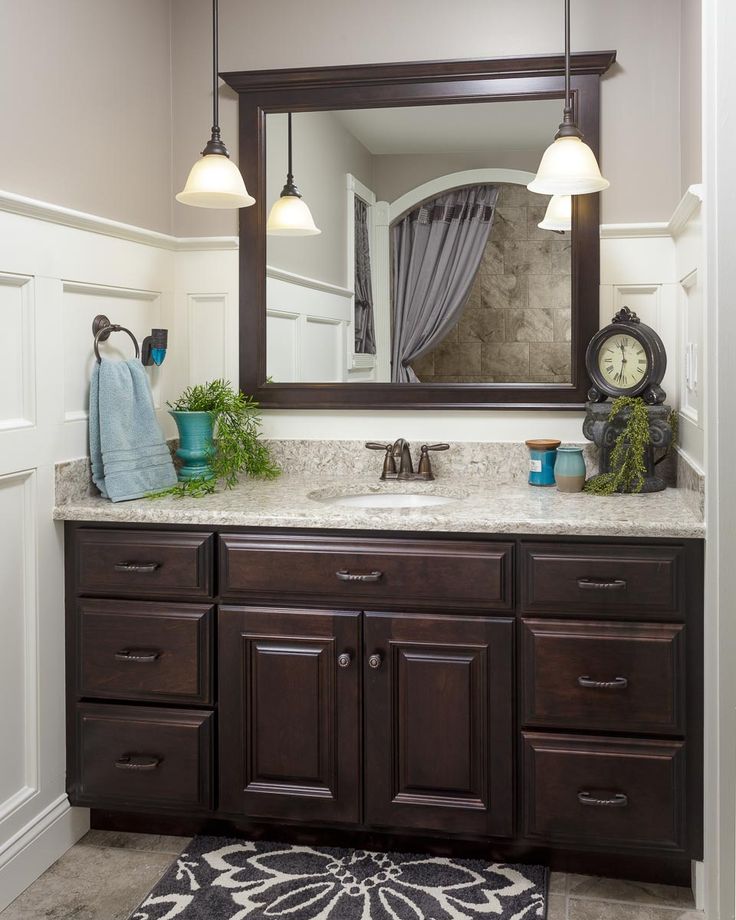 This means that there's no need to stain, paint, or pre-treat the wood to make it resistant to rot, but the wood does weather and change in color, aging to a more grayish tone as opposed to the reddish or brown tones the shingles start their lives as. That doesn't mean that unpainted wood shingles will never rot, but in concert with appropriate detailing and installation, like overlapping each shingle so that water drains down off the shingle rather than trapping water underneath it, cedar siding can last decades.
This means that there's no need to stain, paint, or pre-treat the wood to make it resistant to rot, but the wood does weather and change in color, aging to a more grayish tone as opposed to the reddish or brown tones the shingles start their lives as. That doesn't mean that unpainted wood shingles will never rot, but in concert with appropriate detailing and installation, like overlapping each shingle so that water drains down off the shingle rather than trapping water underneath it, cedar siding can last decades.
This Melbourne home designed by Andrew Maynard and Mark Austin is made up of a series of renovated gabled structures, and the contrast of its white steel panel and western red cedar shingle cladding emphasizes its geometric forms.
Wood Roofing
Using wood siding or shingles on the roof can seem even more counter-intuitive than using wood siding. However, similar principles apply here too: you want to make sure you're using a type of wood that's resistant to moisture, and that the wood is installed or applied in the correct manner.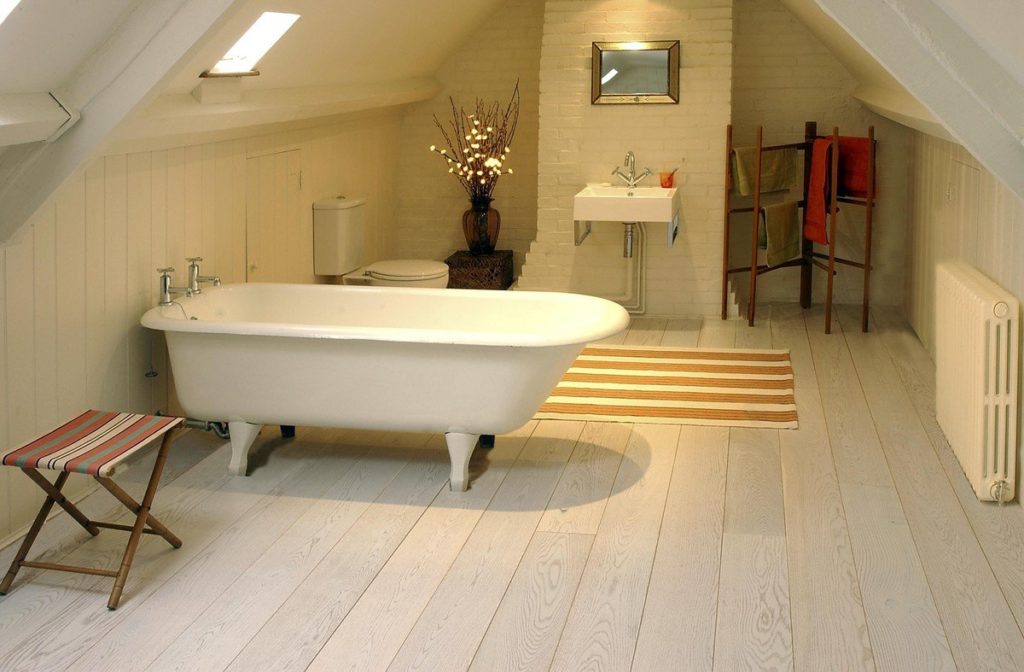
"In this house, the roof is the only facade—the rest is dissolved beneath it." —Architect Aljoša Dekleva
Wood roofs are less common than wood siding, but in colonial America, they were the most common type of roofing material. Today, they're still used, especially in projects that want to achieve a traditional-meets-modern feel or in areas where cedar is easy to obtain and relatively inexpensive. Wood roofing is also seen as more sustainably oriented than other materials. This is because wood is a renewable resource and cedar roof shingles have a relatively long life of more than 60 years (when cared for and maintained). For example, if a wood roof does start to exhibit signs of mildew or moss, you can buy exterior spray applications than can be applied to remedy the issue.
The late Jens Risom's 1967 prefab off the coast of Rhode Island
Wooden Kitchen Countertops
Compared to more durable materials like stone, wood countertops might seem inadequate and even inappropriate, especially if they’re used around a sink area, where water is constantly splashing over the edge and pots and pans tend to pile up.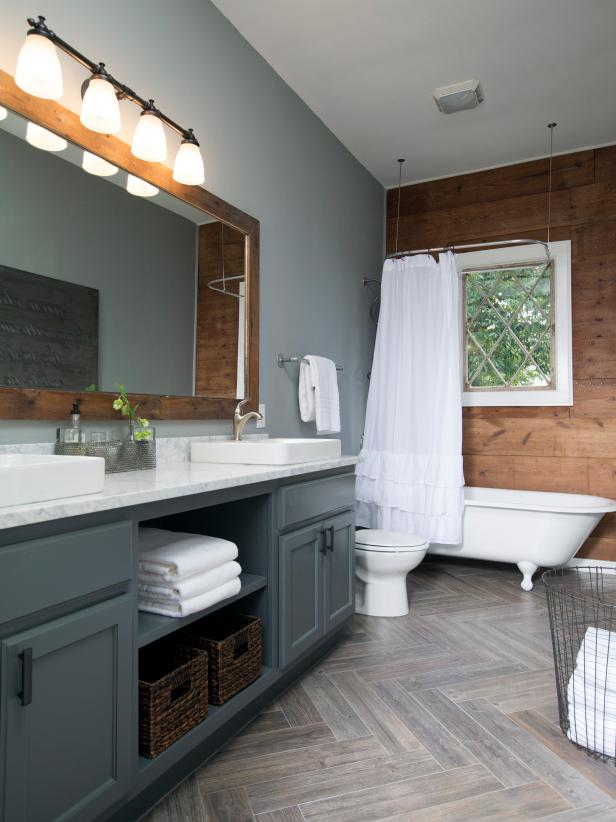 However, countertops made out of wood like butcher block (a laminated piece of hardwood) have successfully been used for centuries. Wood countertops, whether they’re made of solid wood like large slabs of walnut or a classic maple butcher block, can create a warm, natural feel in a kitchen and can reduce the noise of pots and pans landing on the countertop.
However, countertops made out of wood like butcher block (a laminated piece of hardwood) have successfully been used for centuries. Wood countertops, whether they’re made of solid wood like large slabs of walnut or a classic maple butcher block, can create a warm, natural feel in a kitchen and can reduce the noise of pots and pans landing on the countertop.
Shane Michael Pavonetti, an Austin-based architect and contractor, and his wife, Holly, built their eco-friendly home on a lean budget of $175,000. The cedar siding used on the exterior reappears throughout the house. Keen on recycling the wood, the couple added shelving to their kitchen as well.
But that doesn’t mean that all species of wood make for good countertop surfaces, or that there’s little to no maintenance involved. Softer species of wood, like pine, typically don’t make for ideal countertops because of how quickly they dent and scratch. While it's possible to use sandpaper to refinish wood that’s been scratched, refinishing an entire countertop that’s been dented or damaged can be challenging and avoided if harder woods like birch, beech, or maple are selected.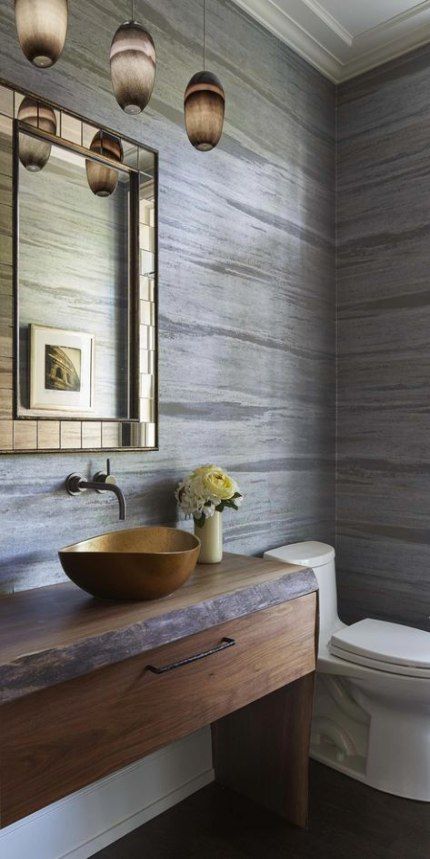 Additionally, wood countertops should be oiled once per month if the surface is unfinished, or refinished every five years if it comes pre-finished from the shop. This will protect the wood from most stains and water damage, but it does require frequent upkeep.
Additionally, wood countertops should be oiled once per month if the surface is unfinished, or refinished every five years if it comes pre-finished from the shop. This will protect the wood from most stains and water damage, but it does require frequent upkeep.
The Mandayam–Vohra family's Brooklyn kitchen is highlighted by a gold hood that complements Workstead’s signature three-arm chandelier, shown here in its horizontal configuration.
Wood Surfaces in the Bathroom
Given the constant humidity in a bathroom, it's probably not most people’s first choice when it comes to selecting a finish for this room, especially when ceramic tiles and other non-porous surfaces are available in a wide range of colors and prices. However, because of its organic, natural appearance and warmth to the touch, as opposed to the cold feel of tile, wood has become a more common choice in bathrooms.
If wood is used as a wall, floor, or ceiling finish in a bathroom—especially one with a bathtub or shower—you’ll want to make sure you have a fan installed for proper ventilation. This will also protect the wood from warping and reduce the chance of mold or mildew from growing. Another good idea is to make sure that the wood is coated in some kind of sealant, perhaps boiled linseed oil and/or urethane, to protect it further—and make sure you get all the end grains covered too, even if they won’t ultimately be exposed. Experts also suggest applying a layer of tar paper (usually used under roof shingles) before installing the wood for an added layer of ventilation and protection.
This will also protect the wood from warping and reduce the chance of mold or mildew from growing. Another good idea is to make sure that the wood is coated in some kind of sealant, perhaps boiled linseed oil and/or urethane, to protect it further—and make sure you get all the end grains covered too, even if they won’t ultimately be exposed. Experts also suggest applying a layer of tar paper (usually used under roof shingles) before installing the wood for an added layer of ventilation and protection.
Wooden Bathtubs
Finally, we arrive at the biggest mystery of them all: a wooden bathtub. A bathtub made out of wood feels like it should either leak non-stop or swell up so much that it loses its shape. But many cultures across the globe have been successfully producing wooden bathtubs for centuries: the Japanese have used aromatic woods like cedar and hinoki to make soaking tubs called ofuro, while teak and other woods have been employed in tubs in Scandinavian countries.
The bathtub is a simple box made of fragrant hinoki cypress. Its shape echoes one of Cho’s favorite inspirations: a wooden apple crate.
The trick to making a wooden bathtub work is—like all uses of wood—to make sure that the proper species of wood are selected from the beginning, and that the wood is regularly maintained. Teak, for example, was often used on the decks of ships, and works well as a bathtub material because of its resistance to rot. Most experts advocate for multiple layers of sealant on wooden bathtubs to provide continued protection against the wet-dry cycles that the tubs go through, which can often make the wood more textured than it initially was, causing hair or skin to get stuck in it.
A Japanese hinoki bowl and stool from Mjölk sit next to a custom hinoki bathtub by Bartok Design in the tub room.
For wood that's traditionally been oiled rather than sealed, like Japanese hinoki, sealing the wood cuts off its notorious scent, but allows it to constantly dry and then swell, ultimately causing leakage and staining.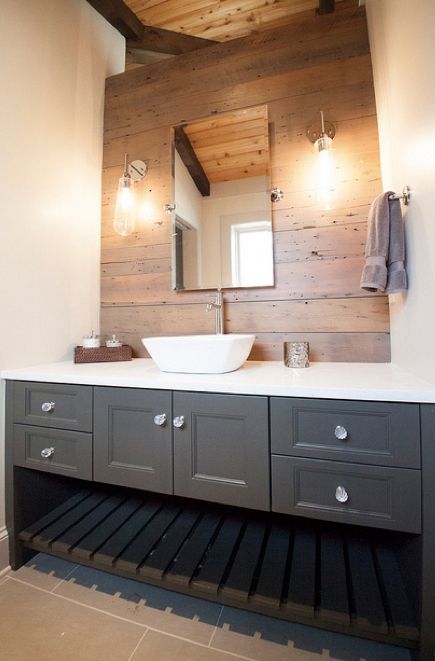 To avoid this, it’s best to keep the bathtub out of direct sunlight, apply sunflower oil to all of the tub surfaces, and keep the moisture level constant by using a lid or cover over the tub when it’s not in use.
To avoid this, it’s best to keep the bathtub out of direct sunlight, apply sunflower oil to all of the tub surfaces, and keep the moisture level constant by using a lid or cover over the tub when it’s not in use.
Overlooking Portage Bay in Seattle, this house was designed by Heliotrope Architects for a bachelor who longed for a simple bathroom with a Japanese-style hinoki tub that was installed in front of the windows for the water views.
Published
Last Updated
Topics
BathHow-To & Guides
Bathroom made of wood: pros and cons
Exploring what types of wood materials and under what conditions will withstand high humidity, and how much it will cost
Wooden fronts of bathroom furniture and shelves for towels and accessories look very stylish.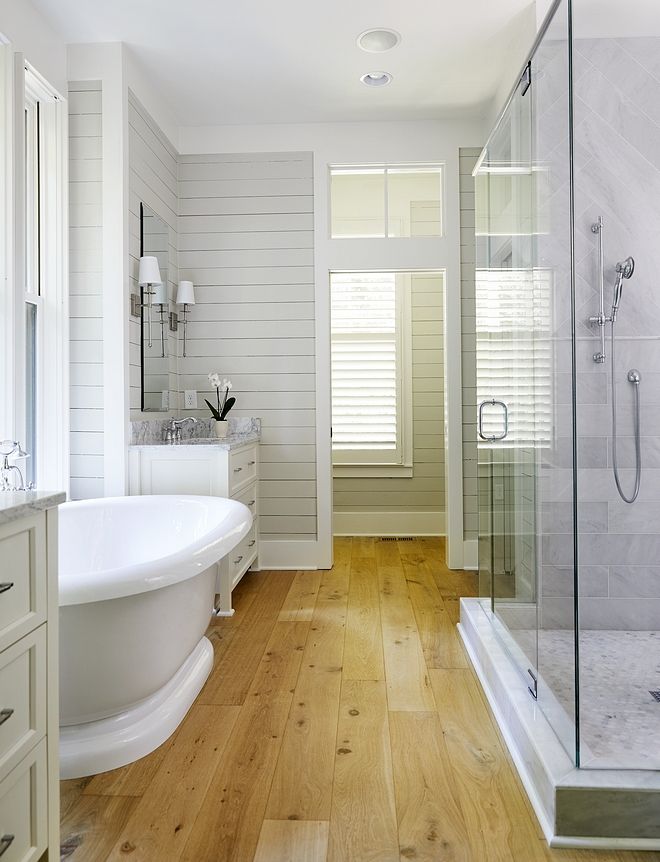 Given that Scandinavian, eco-style and rustic style, which are popular in our time, use the texture of wood as an accent, the question arose sharply: is this a reasonable solution - a tree in the bathroom? This material is not very resistant to moisture: it tends to swell, swell and crack. However, wooden ships and sauna finishes hint to us that the effect of moisture on wood is a solvable problem. Which tree to choose and how to protect it, or is it worth considering alternatives?
Given that Scandinavian, eco-style and rustic style, which are popular in our time, use the texture of wood as an accent, the question arose sharply: is this a reasonable solution - a tree in the bathroom? This material is not very resistant to moisture: it tends to swell, swell and crack. However, wooden ships and sauna finishes hint to us that the effect of moisture on wood is a solvable problem. Which tree to choose and how to protect it, or is it worth considering alternatives?
Bathroom made of wood: what's right?
Even within the same bathroom, humidity levels can vary. It is one thing to place it in the so-called wet zone, that is, directly at the bath or shower, where water constantly gets on the material. The other is a corner remote from water sources. There are also options for placing wooden objects near the bathtub and sink, when drops of water can occasionally fall on the surface, but the humidity is still high.
In the first case, it is recommended to use ceramic or plastic instead of wood.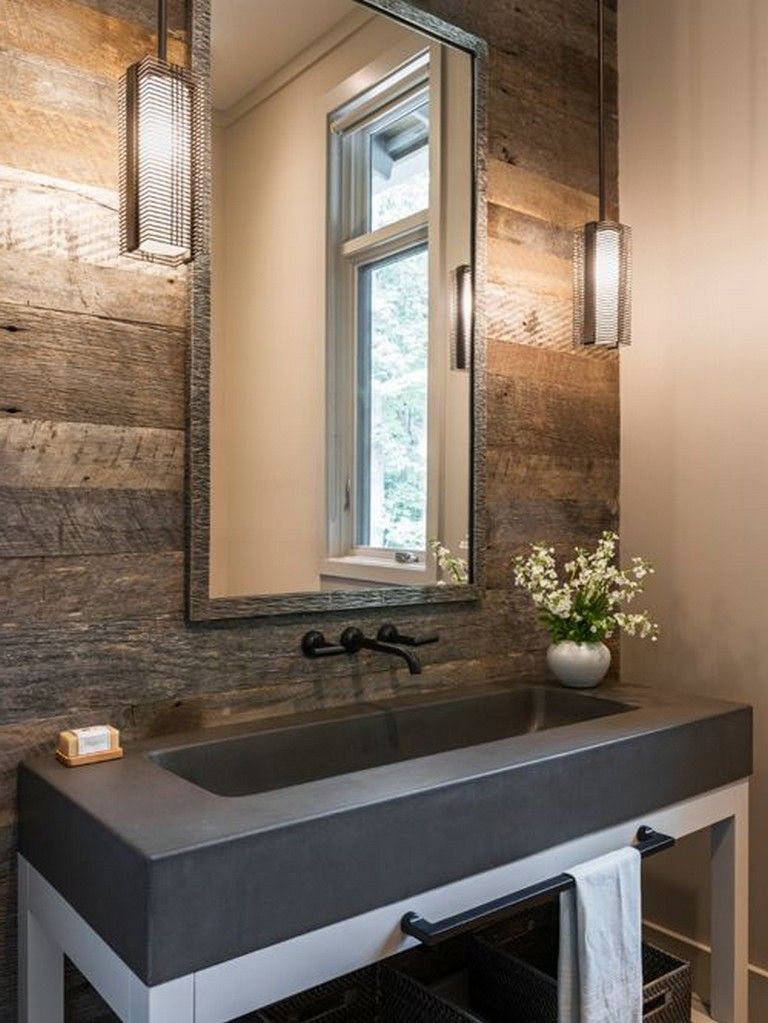 But there are types of wood that can withstand high humidity when properly processed: oak, ash, Brazil walnut, beech and elm. You can even make a bath, shower or sink out of them.
But there are types of wood that can withstand high humidity when properly processed: oak, ash, Brazil walnut, beech and elm. You can even make a bath, shower or sink out of them.
Wood with lower resistance to moisture but comfortable with water and steam:
- bamboo;
- cork tree;
- merbau;
- mahogany;
- teak;
- larch;
- cedar;
- balau;
- bakuri.
Other types of wood are recommended to be kept as dry as possible.
Alternatives to solid wood
The most reliable thing in a bathroom is solid wood. But such material is very expensive. How to be?
Image caption
Firstly, only furniture facades can be made from solid wood, this will save on the amount of material. Secondly, you can use a special moisture-resistant MDF. Chipboard and fiberboard are also suitable and cost even less, but are less moisture resistant, they cannot be used in close proximity to a wet area.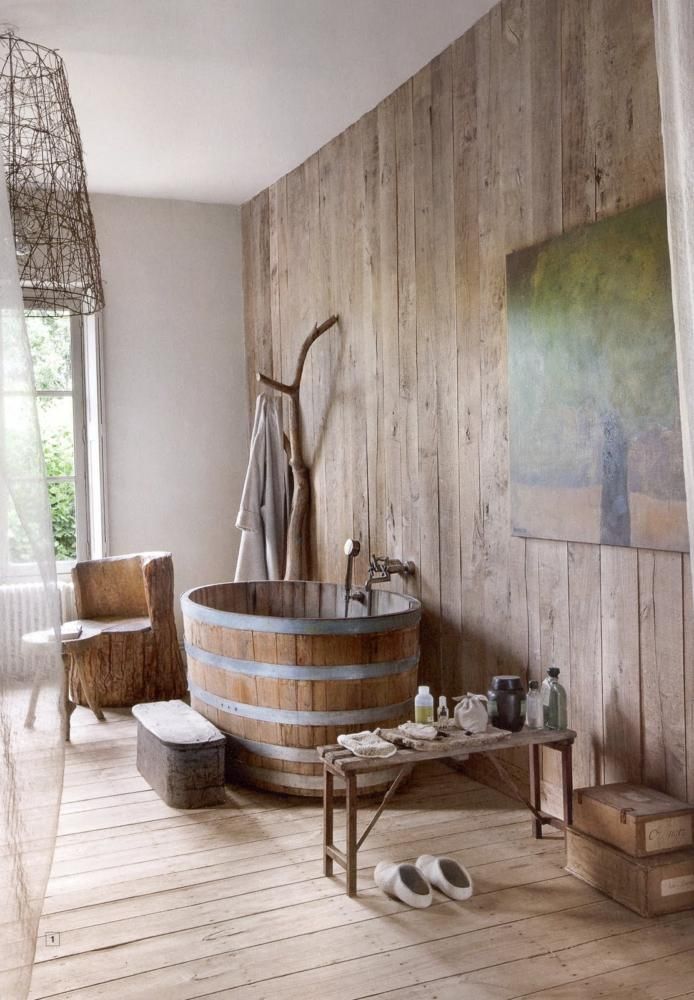 Often, furniture made of inexpensive material is covered with veneer, but with a lack of ventilation, due to changes in humidity and temperature, the veneer cracks rather quickly and begins to move away.
Often, furniture made of inexpensive material is covered with veneer, but with a lack of ventilation, due to changes in humidity and temperature, the veneer cracks rather quickly and begins to move away.
Woodworking
No matter what kind of wood is used in the bathroom, its processing is of paramount importance. Furniture, materials and accessories specially designed for the bathroom are processed in production, and you only need the right care.
The most popular method is moisture resistant varnishing. Such a coating serves as a reliable external protection, however, any damage to the surface will allow moisture to get inside. In this regard, another method - impregnation - will serve as an additional precaution.
Care Instructions
If any wood gets in contact with water outside the wet area, wipe it off as soon as possible with a dry cloth. A prerequisite for keeping wood in the bathroom is excellent ventilation.
To keep the furniture in good shape for longer, it is recommended to renew the impregnation or lacquer every 3-5 years.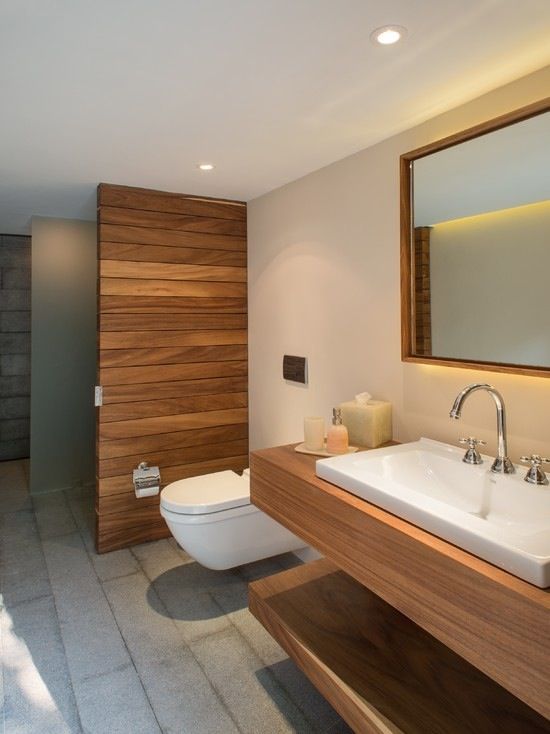
Keep furniture away from the bathtub. Even with a curtain, spray will constantly fall on the tree. At least make a glass partition between the zones.
If there are open holes inside the wooden bathroom furniture (for example, the manufacturer has given the option to choose the height of the shelf), insert plugs into them or treat the holes with sealant.
Fake wood
Some solutions allow you to bring the cosiness and naturalness of wood into the bathroom without using this material. The floor and walls can be tiled with wood imitation.
Plastic can also imitate the surface of wood. Often the textured wooden facades of bathroom cabinets are MDF, decorated with PVC film.
If you are crazy about wooden surfaces and naturalness in the interior, you will be interested to read:
- “1/4 closer to nature: wood accent wall”
- "Forest in the house"
- "How to use tree branches in the interior: 7 ideas"
Photos: inmyinterior. com, home-designing.com, surfacesusa.com, homedit.com, iseecubed.com, virtualreel.com, dwell.com
com, home-designing.com, surfacesusa.com, homedit.com, iseecubed.com, virtualreel.com, dwell.com
When it comes to taking care of wood and keeping it in top condition, the first thing to do is to know what wood it is and then act one way or another. In the next article, we'll show you the best woods you can use in your bathroom. and the best way to care for and support them.
Index
- 1 Types of wood for the bathroom
- 2 Care and maintenance of the wooden floor in the bathroom
Types of wood for the bathroom
The vast majority of wood used in the bathroom is usually teak or larch. In the first case it is a tropical and waterproof wood. This makes wood ideal for use in the bathroom.
Another type of wood commonly used in the bathroom is larch. This is a type of wood that is quite resistant to water, is so perfect for use on floors or in bathroom sinks.
Although it is fairly water resistant, we must not forget that wood is a very delicate material and it is important to follow a number of tips or guidelines when keeping it in perfect condition. . In no case is it recommended to expose the wood in the bathroom to temperatures above 60 degrees, as it may be damaged. It is preferable to always use a neutral soap during cleaning and maintenance.
Care and maintenance of the wooden floor in the bathroom
The wooden floor will require maintenance series to prevent moisture or bath water from damaging it. Maintenance and care of the floor will largely depend on the type of wood used for it:
- In the case of wood treated with oil, as in the case of teak, it is best to use a cleaner suitable for this type of wood or use some neutral soap . It is very important to remove all remaining water from the surface and always have completely dry wood.
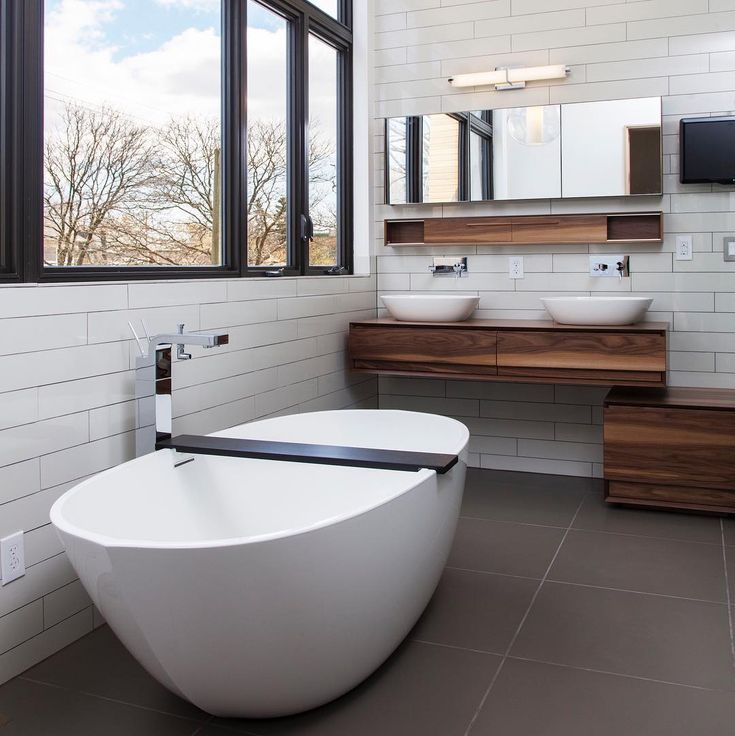
- In the case of wood on a varnished floor, it is best to apply a little neutral soap. Use a damp cloth and soap will remove any accumulated dirt. The next thing to do is dry the entire surface very well with a clean cloth. Lacquered wood looks great in the bathroom, but requires special care to avoid damaging it. The big problem with polish is that it's not waterproof, so moisture can seriously damage the polish itself. In the event that certain scratches are observed on the surface, it is best to sand the entire surface so that the wood floor remains as good as new. There are times when the wood has lost almost all of its luster and it is convenient to reapply a little varnish over the entire surface.
- The last type of wood when it comes to flooring is natural. Natural wood is the hardest of all and therefore requires less maintenance than lacquered wood and oil treated wood. When cleaning and finishing possible stains that have accumulated over time, simply apply some water with a clean cloth.

